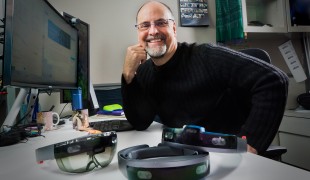- 3532
- 309
- 12
- 5
- 0
- Help Ukraine
About the solution
When Chelsea Elliott failed her eye screening, it revealed that she was blind in her left eye. This meant that for the next few days, she was making trips to eye doctors to determine the cause of her vision loss. After many trips back and forth, finally, a retina specialist named Jose “Pepe” Martinez made the diagnosis: Coats’ disease. This disease is rare, and causes monocular ailment, which facilitates the creation of blood vessels in the back of the eye, leading to constriction and rupture. As the disease progresses, leakage causes the retina to swell and eventually detach, resulting in permanent blindness.
Two years later, Chelsea failed again a required hearing test at her elementary school and discovered she was also deaf in her right ear, resulting from the absence of three small bones in her middle ear that was likely dissolved by infections she had as an infant and not the direct result of Chelsea would suffer another setback as a teenager when a cataract formed on her lens, and her blind eye became noticeably smaller than her other eye. After consulting with doctors, the decision to remove the eye was made. Six weeks after recovering from her surgery,
The creation of half Helen, began shortly after graduating from St. Edward’s University in 2013 when Chelsea learned about the Spot camera. This revolutionary new tool takes 23 measurements of the eye within seconds. Unlike the standard eye chart, which can only measure an individual’s distance acuity, the Spot camera is able to identify six of the most common vision impairments in infants as young as six months old. At the same time, the American Academy of Pediatrics recommended that children as young as three have vision screenings. Chelsea realized that if the camera and these new recommendations had been in place when she was a child, her doctors could have spotted her disease sooner and possibly saved her eye.
Using her graduation money, she set out to start a half Helen Foundation, a nonprofit organization that provides preventive vision and hearing screenings. With the help of the West Austin Lions Club and other donors, Chelsea purchased half Helen’s first Spot camera and two audiometers for screenings. As of 2021, half Helen had screened over 60,000 children in Hawaii and Texas! If children need additional services after being screened, hH works to ensure they receive a full eye exam and corrective wear.
This story was adapted from https://halfhelen.org/about/
Find them at https://halfhelen.org/
The images were taken from https://halfhelen.org/ as we do not own any of them.
This solution shall not include mention to the use of drugs, chemicals or biologicals (including food); invasive devices; offensive, commercial or inherently dangerous content. This solution was not medically validated. Proceed with caution! If you have any doubts, please consult with a health professional.
DISCLAIMER: This story was written by someone who is not the author of the solution, therefore please be advised that, although it was written with the utmost respect for the innovation and the innovator, there can be some incorrect statements. If you find any errors please contact the patient Innovation team via info@patient-innovation.com
-
-
520
-
0
-
7293

Man launches platform so that mothers and pregnant women can benefit from health services
COMMUNICATION: Communicating, whether by speaking, listening, or other means
(SELF)-CARE: HYGIENE: Maintaining personal hygiene
CAREGIVING
Pregnancy
App (Including when connected with wearable)
Website
Enhancing health literacy
Promoting self-management
Building Supportive Community Relationships
Promoting inclusivity and social integration
To improve Treatment/Therapy
Preventing (Vaccination, Protection, Falls, Research/Mapping)
Support on Puerperium/Post-childbirth
Raise awareness
General and Family Medicine
Gynecology and Obstetrics
Infectious Diseases
Pediatrics
Public Health
Tropical Medicine
Niger
-
-
-
378
-
0
-
4279

Using AI to allow blind people to find familiar faces
COMMUNICATION: Communicating, whether by speaking, listening, or other means
Social interaction
Blindness
5 Senses support devices: (glasses, hearing aids, headphones...)
Body-Worn solutions (Clothing, accessories, shoes, sensors...)
App (Including when connected with wearable)
AI algorithm
Assistive Daily Life Device (to help ADL)
Difficulty communicating with environment
Confusion
Regaining sensory function
Promoting self-management
Promoting inclusivity and social integration
Improving Speech and Communication
Raise awareness
Ophthalmology
Pediatrics
United States
-
-
-
419
-
0
-
5447

Blind Entrepreneur creates language-based instructions for LEGO construction toys
-
 en
en